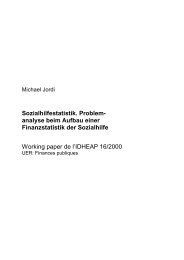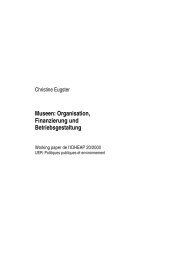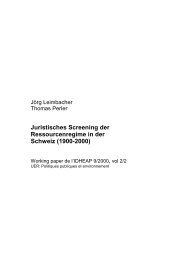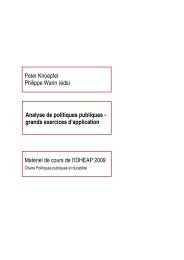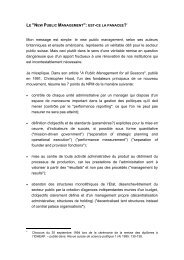Local Government and Metropolitan Regions in Switzerland - IDHEAP
Local Government and Metropolitan Regions in Switzerland - IDHEAP
Local Government and Metropolitan Regions in Switzerland - IDHEAP
Create successful ePaper yourself
Turn your PDF publications into a flip-book with our unique Google optimized e-Paper software.
Section 5: F<strong>in</strong>anc<strong>in</strong>g the governance role of local government<br />
Swiss municipalities – as already mentioned – enjoy a far-reach<strong>in</strong>g fiscal sovereignty. They are allowed<br />
to have their own fortune or might be <strong>in</strong> debt. And they f<strong>in</strong>ance their activities themselves - at least<br />
those which fall <strong>in</strong>to their own realm <strong>and</strong> are not subsidized by higher levels - through tax, fees <strong>and</strong><br />
charges. Therefore they have to establish a local book-keep<strong>in</strong>g which has to abide by the cantonal prescriptions.<br />
They also have to prepare a budget, which they have to submit to the local parliament, the<br />
assembly or sometimes directly to the citizens. The f<strong>in</strong>ancial control is exercised first by municipal<br />
committees <strong>and</strong> secondly by the cantonal adm<strong>in</strong>istration, which supervises the book-keep<strong>in</strong>g. If the<br />
municipalities abuse their liberties, the canton steps <strong>in</strong>. This, however, rarely happens.<br />
To cover their expenses municipalities levy taxes. With<strong>in</strong> a quite broad marg<strong>in</strong> usually fixed by the canton,<br />
they set the rate of the local tax on <strong>in</strong>come <strong>and</strong> property. Swiss citizens thus pay tax at all three<br />
levels of state. <strong>Local</strong> taxes amount to a little more than one third of the total <strong>in</strong>dividual taxation <strong>and</strong> are<br />
paid directly to the municipality; a little more than one third is paid directly to the canton <strong>and</strong> a little less<br />
than 30 percent goes to the federal state. The exact amounts an <strong>in</strong>dividual has to pay to the three levels<br />
depend, of course, on his or her <strong>in</strong>come, because the progression of the federal tax rate differs from the<br />
ones <strong>in</strong> the municipalities <strong>and</strong> the cantons.<br />
A result of the far-reach<strong>in</strong>g fiscal autonomy are the huge differences <strong>in</strong> terms of tax an <strong>in</strong>dividual has to<br />
pay depend<strong>in</strong>g also on the municipality <strong>and</strong> on the canton he or she lives <strong>in</strong>. A father of three children<br />
earn<strong>in</strong>g 200,000 Swiss francs a year <strong>and</strong> liv<strong>in</strong>g <strong>in</strong> the City of Zurich has to pay 12,000 francs to the<br />
municipalities whereas <strong>in</strong> the neighbour<strong>in</strong>g municipality of Zollikon he would only have to pay 7,200<br />
francs. And, liv<strong>in</strong>g <strong>in</strong> the canton of Zurich, he additionally has to pay 10,000 francs <strong>in</strong>come tax to the<br />
canton. If he were to move to the canton of Jura, he would have to pay 20,000 francs whereas <strong>in</strong> the<br />
canton of Schwyz it would only by 6,500 francs. 22<br />
Direct taxes on <strong>in</strong>come <strong>and</strong> property provide the biggest part of the revenue of the municipalities, as<br />
well as of the cantonal level with 38 <strong>and</strong> 35 percent respectively (see table 2). The second most important<br />
source of revenues for municipalities is fees <strong>and</strong> charges with almost 30 percent followed by transfers<br />
from the canton (17 %) or other municipalities (4 %). Transfers without any specific purposes are<br />
relatively low (4 %).<br />
The structural differences between the municipalities – <strong>and</strong> more specifically the lack<strong>in</strong>g possibilities of<br />
some municipalities to generate sufficient tax <strong>in</strong>come – make sophisticated systems to balance <strong>in</strong>equalities<br />
necessary. On one h<strong>and</strong> there are transfers from richer to poorer municipalities, on the other h<strong>and</strong><br />
the cantons allot more money to the less affluent municipalities. The function<strong>in</strong>g of these systems, which<br />
were often based on the f<strong>in</strong>ancial situation of the municipalities <strong>and</strong> directly l<strong>in</strong>ked to special activities,<br />
has been heavily criticized <strong>in</strong> recent years, <strong>and</strong> most of the cantons are – as we shall see – about to<br />
reform them.<br />
In general, however, the f<strong>in</strong>ancial situation of the municipalities is, apart from some exceptions, much<br />
better than the one of the Confederation or the majority of the cantons. In 2007 the estimated total debt<br />
of the public sector amounts to about 224 billion Swiss francs (about 49 percent of the gross domestic<br />
product). This is about 16 percent of the total public debt. The share of the cantons with 28 percent is<br />
higher <strong>and</strong> the most important part with 56 percent derives from the Federal level. 23 In the light of these<br />
figures it is not astonish<strong>in</strong>g that there is a tendency of the higher political levels to make the lower ones<br />
pay more for public services.<br />
22 For calculations see http://www.estv.adm<strong>in</strong>.ch/data/sd/d/<strong>in</strong>dex.htm?berechnungen/<strong>in</strong>halt.htm .<br />
23 See: http://www.efv.adm<strong>in</strong>.ch.<br />
13




